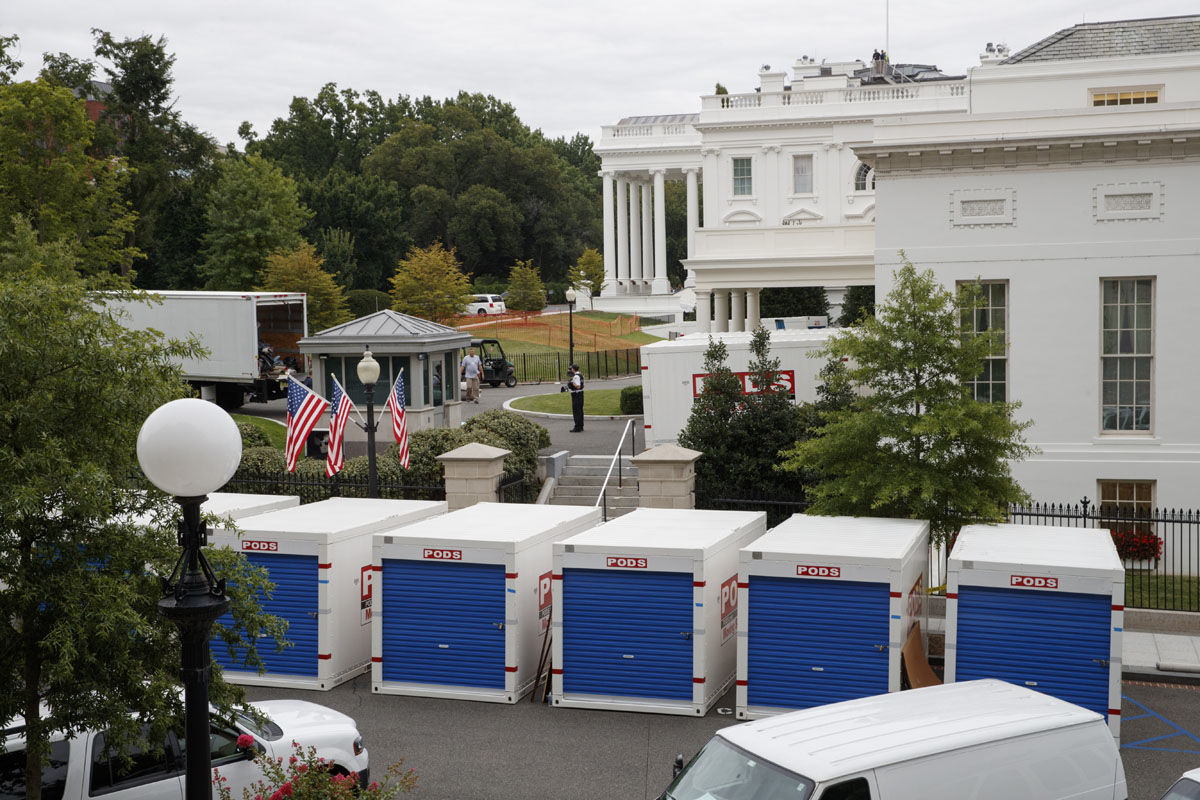Table Of Content

Alfred Mullett’s interpretation of the French Second Empire style was, however, particularly Americanized in its lack of an ornate sculptural program and its bold, linear details. Originally built for the State, War, and Navy Departments between 1871 and 1888, the Eisenhower Executive Office Building now houses a majority of offices for White House staff. The private residence of the first family is located on the second floor. In addition to the Presidential Bedroom Suite, the second floor includes historic spaces, such as the Queens’ Bedroom, the Treaty Room, the Yellow Oval Room, the Center Hall, and the East and West Sitting Rooms. Detail of a project for President Roosevelt's eastward addition to the east wing, Office of Lorenzo Winslow, 1943. Construction under way for the new third floor, seen from the east wing in the summer of 1927.
Architecture: 1900s-1940s
What complicates a reconciliation of the Jefferson and Walter plans is the odd fenestration shown in 1853. While we can expect the room division walls to vary from the regularity of the exterior features, four blind windows shown on Walter’s west wing plan for the first five bays produce an awkward collision with internal walls. These include a period drawing, personal and official correspondence, and physical evidence shown in photographs.
Executive Office of the President
Generally, the White House Christmas theme is revealed around Thanksgiving, but you should request your tickets before then. Most tours take place before noon, and they can be canceled at a moment’s notice depending on official engagements and an ever changing political landscape. No, White House tours, including Christmas tours, are always free of charge. However, reservations are required, and must be reserved with your state representative well in advance. Please keep in mind that the White House can change your tour date or time, and even cancel your tour entirely with very little notice.
The East and West Wings of the White House
This 18 foot round by 16 foot deep structure was not unlike the ice house constructed as part of the north wing at Monticello in 1802. The ice house was then joined to the west side of the basement level by what must have been a simple frame structure that also served to shelter the preexisting well just west of the house. Since the 1940s Jefferson has stood in oversize bronze in the Jefferson Memorial, gazing north toward the White House. Jefferson would not lament the loss of his architectural vision or the treatment of his special wings, for he was known to favor the future over the past.

The vault not only made for a fireproof floor but created a cellar space below, as the stairway indicates. What the cellar was used for is unknown, although the proximity might indicate that it could have housed wood for the fires above. The possibility that the fireplace was located below the space seems to be negated by Jefferson’s use of the word “cellar,” which implies storage.
Making the pavilion’s upper floor level with the north grade would pose yet another grade-building height to conquer, especially with a steeper grade for horses and carriages. At the same time Jefferson affirmed what he had drawn in his wing plan, that the stables and coach house would be closer to the house, even if temporary. Latrobe raised a good question when asking how carriages and horses would exit through the southern colonnade. By 1870 the ice house had been floored over for a black servants’ dining room and lounge, hiding that ear- lier feature for the rest of the century.
2023 Holidays at the White House - The White House
2023 Holidays at the White House.
Posted: Mon, 27 Nov 2023 14:51:20 GMT [source]
Latrobe’s initial task at the White House was to replace a leaking roof of slate embedded in mortar and gutters that were letting buckets of water into the house, threatening to destroy the few newly installed architectural finishes. Jefferson also called upon Latrobe to fix the two new water closets on the Second Floor that were fed from rain-collecting cisterns in the attic. Jefferson redesigned the grand, but unbuilt, west stair- case that Latrobe would construct off-axis in order to open the vista and public access to the terrace promenade once there was a wing built to support it. A similar glass door was retrofitted in the similar eastern Serliana or venetian window for east wing terrace access. Latrobe considered his own drawings the more accurate ones for Lenthall to follow while reconciling Jefferson’s ideal design regularity to the reality of wall thicknesses and the practical space in each room. Walter’s plan, subsequent plans, and what is still stand- ing of the west wing confirm that exterior appearance and style did matter.
Biden tells Howard Stern he’s ‘happy to debate’ Trump
Digging for the west wing began in the summer of 1804 under the direction of architect and engineer Latrobe and his assistant and construction supervisor Lenthall, the same team working on the Capitol construction under Jefferson’s supervision. Jefferson had chosen the right man to undertake the most complex of American building projects. Having confirmed Latrobe’s skills as the most accomplished, and arguably the only, professional architect and engineer in America, Jefferson hired him in March 1803 as surveyor of the public buildings, a position he held until 1811. The West Wing also houses the Situation Room, the Cabinet Room, the Press Room, and offices for advisors and the chief of staff. Additional offices for the president’s staff are located in the Eisenhower Executive Office Building.
Becoming FDR: The Personal Crisis That Made a President
With structural problems mounting from the 1902 installation of floor-bearing steel beams, most of the building’s interior was stripped bare as a new concrete foundation went in place. The Trumans helped redesign most of the state rooms and decorate the second and third floors, and the president proudly displayed the results during a televised tour of the completed house in 1952. The East Wing as it exists today was added to the White House in 1942 primarily to cover the construction of an underground bunker, now the Presidential Emergency Operations Center (PEOC). Around the same time, Theodore Roosevelt's coatroom became the movie theater. Later, offices for correspondence, calligraphers and the social secretary were placed in the East Wing.
The ground floor originally housed service areas, but now includes the Diplomatic Reception Room, the White House Library, the Map Room, the Vermeil Room, and the China Room. The State Floor features some of the White House’s most treasured spaces, including the East Room, the Blue, Red, and Green Rooms, the State Dining Room, and the Family Dining Room. The White House today holds 132 rooms on six floors, the floor space totaling approximately 55,000 square feet.
Later, in 1935, it became a library and remains a frequent location for media tapings today. The residence features a 42-seat movie theater and a tennis and basketball court. The White House bowling alley was given as a gift to President Truman and was later moved to the basement of the Eisenhower Executive Office Building. “There had been a pool inside the White House added by Franklin Roosevelt that he would use as exercise for his polio, but later, Gerald Ford wanted an outdoor pool,” says Fling.

The furnace room (now the Diplomatic Reception Room) also jutted into the corridor. When McKim, Mead, & White created a new guest entrance in the East Wing during the 1902 renovation of the White House, they transformed much of the Ground Floor into public space. All intrusions were removed, the vaulting was restored, and the refurbished corridor received rugs and seating furniture. Many of our most celebrated national figures have participated in historical events that have taken place within the EEOB’s granite walls. Theodore and Franklin D. Roosevelt, William Howard Taft, Dwight D. Eisenhower, Lyndon B. Johnson, Gerald Ford, and George H. W. Bush all had offices in this building before becoming President.

No comments:
Post a Comment